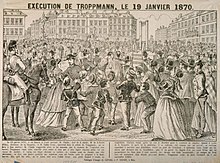Jean-Baptiste Troppmann
Jean-Baptiste Troppmann (born October 5, 1849 in Brunstatt , † January 19, 1870 in Paris ) was a French eightfold murderer. The murders of a family he committed received extensive coverage in the French press. This reporting was an essential milestone in the development of the French tabloid press (the “petite presse” or the “presse à un sou”).
The fact
Born in Alsace, Troppmann went on a trip to Herrenfluh near Cernay with the Roubaix- based family man and industrialist Jean Kinck at the end of August 1869 . After poisoning Kinck with hydrogen cyanide, he asked the victim's wife, Hortense Kinck nee Roussel, for money. She sent him, assuming he was making this request for her husband, her eldest son Gustave with a check. Troppmann could not cash the check without the murdered man. He killed the son and dismembered his body. He then arranged a meeting with Hortense Kinck, who was six months pregnant in Paris . She brought 55,000 francs to this meeting again, assuming that her husband needed this money. After receiving the money, Troppmann killed Mrs. Kinck and her five children between the ages of 2 and 13 and buried them two kilometers from Paris in a field between the “Fort d'Aubervilliers” and the Pantin train station . These bodies were found the following day, September 20th. Initially, as they could not be found, Jean Kinck and his son Gustave were suspected of the act, until two days later Troppmann was found in possession of papers and valuables belonging to the Kinck family in the port of Le Havre , where he was going to embark for America. He pretended to have committed the crime with the assistance of Jean and Gustave Kinck and continued to accuse Jean Kinck when Gustave's body was found in Pantin on September 26th.
Only after Troppmann confessed on November 12th that he had started the journey with Jean Kinck to the ruins of the Herrenfluh castle, allegedly to show him a (untraceable) counterfeiting workshop hidden in an underground vault, was the corpse recovered on November 25th the case will be resolved.
Troppmann was convicted of this act and publicly executed on January 19, 1870 at the age of 21 under the guillotine of the Roquette prison in Paris . The place where the guillotine stood can still be clearly recognized in the pavement of the pavement of the Rue de la Roquette by the five large stones that stopped the impact of the 40 kilogram guillotine.
Although Troppmann killed eight people, he's not a classic serial killer . This should not have involved murders that related to a uniform crime scene. Obviously, greed for money alone was the motive. He is more of the mass murderer type . Nevertheless, he is often listed as a serial killer.
The role of the press
From the discovery of the corpses to the hunt for the perpetrator to the trial and the execution, the morality singers and especially the young press followed the Troppmann case. The Le Petit Journal, founded by Moïse Polydore Millaud on February 1, 1863, stood out in particular . This was able to increase the circulation of the first report on this murder on September 23 from 357,000, three days later to 403,950, on the day of Troppmann's execution to 594,000 copies. The paper provided its readers with details such as that Troppmann allegedly asked his brother for hydrogen cyanide and ether in order to poison his guards and that he tried to bite his executioner. With this success, it became apparent just how powerful criminal cases can be for newspapers. The Troppmann case also contributed to the emergence of the so-called “little report”, to the reporters of “faits divers”, who go in search of bloody crimes and sensations and thereby attract the contempt of the critics of information journalism.
Le petit Journal was the first French newspaper to focus on the boulevard instead of subscription as the main channel of distribution, with a price of 5 centimes (relative to the 15 to 20 centimes price of other newspapers), the proverbial one a sou , also very inexpensive. The publisher Millaud had no editorial ambition, he was rather a pure businessman. Le Petit Journal therefore did not seek to express different opinions or to enlighten or inform its readers, but was avowedly apolitical and sought to entertain the readers. The Troppmann affair led to the breakthrough of this paper.
The Troppmann case in poetry and film
The Russian novelist Ivan S. Turgenev , who had witnessed the execution, wrote an eyewitness report, L'Exécution de Troppmann, which was expanded into an essai on the death penalty .
The French poet Maurice Rollinat dealt with the case in Soliloque de Troppmann ( Les Névroses , 1883).
The French historical thriller Der Fall Troppmann (1992, original title: Le cri coupé , director: Miguel Courtois , actors: Julien Guiomar , Alain Beigel , Jean-Francois Garreud , Laurent Vivier , Pascale Arbillot ) took up the case. The focus was less on crime than on the activities of the press, especially Millauds. The film critically questions this activity.
Web links
- If representation of the (English)
Individual evidence
- ^ Jean Baptiste Troppmann (1849-1870). Criminel, author de l'assassinat de la famille Kinck à Pantin en 1869. In: BnF Data. Bibliothèque nationale de France, accessed on August 19, 2019 (French).
- ^ Sylvia Valentin: Journalism in France in the 19th Century, the Change in the Press World in Critical Dialogue . Diploma thesis, Vienna 2000, chapter 3
- ↑ cinema.de Le cri coupé in the Lexicon of International Films
| personal data | |
|---|---|
| SURNAME | Troppmann, Jean-Baptiste |
| BRIEF DESCRIPTION | French eightfold murderer |
| DATE OF BIRTH | October 5, 1849 |
| PLACE OF BIRTH | Brunstatt |
| DATE OF DEATH | January 19, 1870 |
| Place of death | Paris |

